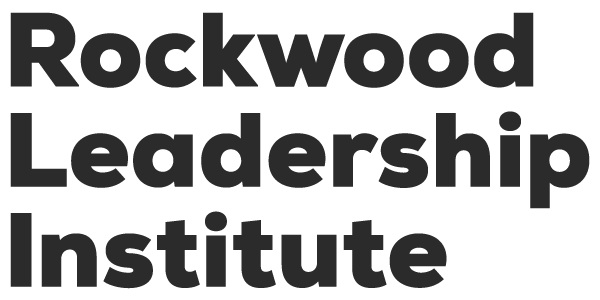
Dearests,
I have the distinct honor and pleasure of having Rajasvini Bhansali serving on Rockwood’s Board of Directors. Over the years, we have had many conversations about the care and feeding of healthy, vibrant organizations, and a few months ago, we decided to co-author a piece about what we’ve learned. It was recently published by the Stanford Social Innovation Review, and I wanted to share it with you, since you are the inspiration for everything we talk about.
So from my heart to yours, here is Rajasvini and my best wisdom about how to lead with grace:
“How did you turn your organization around?”
This is a question nonprofit leaders often ask us, as women of color who have succeeded in leading our organizations to greater stability and social impact. It’s not a question you can answer in a two-minute cocktail-party conversation—or even a five-day workshop—but it’s an important one. So we decided to put our heads together to share some of our insights with the nonprofit sector as a whole. The fact is, the complex problems we face in the 21st century require steady and solid organizations. If we stand any chance of creating long-term change, we need to share sound practices widely, not keep them a secret to protect our own success.
Here’s a snapshot of the state of our organizations when we took over as executive directors and where we are now:
In 2008, Rockwood Leadership Institute’s budget was a little under $1 million and the Great Recession had just begun. About 25 percent of the Institute’s budget was earned income, with 75 percent from foundations and no major donors. Rockwood had a history of paying staff well, but the founder did not take a salary. The organization had run mostly out of the largesse of the founder’s heart and personal pocketbook, rather than on a business model, and now found itself needing to include an executive director’s salary in the budget for the first time. Today, Rockwood Leadership Institute’s budget is $3.2 million, with earned income comprising 56 percent and partnerships with foundations comprising 44 percent.
In 2010, at the height of the recession, IDEX’s operational budget was nearly $500,000. Fifty percent of the organization’s net income came from individual donors and the rest from foundations. There was no multi-year support, and most of the foundation support was restricted. Sixty percent of the budget went into grantmaking,and very little was invested internally; most staff worked at below-market salaries. Today, IDEX has secured the next seven years of general operating support, which provides a solid foundation from which it can grow and innovate. IDEX ended 2014 with a $1.8 million budget and has multi-year, unrestricted support from foundations, as well as funding from major donors and a healthy earned-income stream.
So how did we do it? Here are some ideas, principles, and insights that have guided our organizations, our relationships with funders, and ourselves over the past five to seven years. Our hope is that sharing them can contribute to strengthening our entire nonprofit sector.
THE ORGANIZATION
1. Stay on purpose. This gets tricky, especially in times of economic stress. When things are dicey financially, it can feel like you’re clutching at straws and scrambling—“Let’s try this. Let’s try that. Let’s go after that little piece of money.” The next thing you know, your mission has drifted to a place where your nonprofit can’t recognize itself. Use your organization’s purpose as your single organizing principle.
2. Tell your origin story often. IDEX was formed in the mid-80s as a laboratory to experiment with a new way of doing things in reaction to top-down development aid. Telling its origin story over and over reminds all of IDEX’s stakeholders—board members, staff, volunteers, and funders—that they’re there to do things differently, not as they “ought” to be done. Regularly telling your organization’s origin story will help you stay on purpose.
3. Build something that attracts resources. Avoid chasing funding or peddling scarcity. There’s nothing interesting about scarcity. People want to go away screaming from it. When we think about what draws us to a person, idea, organization, or effort, it’s aliveness, excitement, and a focus on solutions, not problems. Integrate joy, love, and positivity into your organization’s culture, programs, and communications.
4. Make your staff’s wellbeing a priority. For the past six years, Rockwood has had a 32-hour workweek. It found that by asking people to work less, they actually got more done. Although people are working 20 percent less each year, the organization’s programing and finances have tripled, and its staff has stayed the same size (12-14 people). When making decisions, Rockwood’s leadership team regularly asks itself, what is the most humane thing to do here?
5. Practice regular reflection with your whole staff. Once a month, IDEX uses a practice from popular movements in Latin America called coyuntura. Together, staff members ask themselves, “Where are things—really—in this moment? What are the forces shaping the world as we know it, and how do they affect our agency to create change right now?” They also ask, “What are we learning? What can we do differently?” This reflection always comes from a place of curiosity, not of critique.
6. Be in partnership with your constituents. When IDEX was going through a financially challenging period, it was honest with its grantees about why it couldn’t make grants at the same level that year. In response, grantee partners said, “Let us support you in re-strategizing. We can teach you a thing or two about how to adapt.” Instead of turning insular and protectionist, IDEX opened up. It let people from different parts of its community help reshape IDEX’s future.
7. Know your costs; learn to do a true budget. It’s essential for you to know how much it really costs to do business. You can’t make a case to your funders for what you need without being crystal clear yourself. For 20 years, IDEX made multi-year, general-support commitments to its grantee partners and asked for no multi-year, general-support grants for themselves. The organization blew through its reserve regularly, underpaid its staff, didn’t retain talent, and couldn’t build its own resilience to withstand the ebbs and flows of the funding environment. It’s imperative that every executive director understands how to do a budget that includes the true cost of doing businesses. You must do this hard, internal work before you ask for money.
8. Be the right size at the right moment. This is such a crucial piece, but it’s not easy, especially in a culture that wants everything to grow, grow, grow! Rockwood could probably be a much larger organization, but it would lose its ability to be nimble, innovative, and responsive. Staying at a smaller size has allowed it to shift and flex. Be mindful about what size will help you stay on purpose and maintain your staff’s wellbeing. Big is not necessarily better.
9. If you can’t afford it, don’t buy it. We both come from families who knew that money was a means to an end. You need to have x amount, so you don’t go into debt. If we can’t afford something, we don’t buy it. We’ll take conceptual and programmatic risks and leaps of faith, but not on a financial level. We don’t play with our dollars.
THE FUNDERS
10. Be in partnership with your funders. Treat your donors and funders not as a transaction, a teller, or an ATM, but as the real people they are. You are, after all, building something together over the long-term. When you extend the same kind mutual relationship of solidarity you have with your constituents and community to your philanthropic partnerships, you will attract resources. It is OK to ask your funders for what you really need, but that can only happen when you are in real relationship.
11. Communicate with your individual donors like they are intelligent people. For a long time, IDEX relied on the traditional fundraising wisdom that says messaging needs to stay at a fourth-grade level—in other words, to reach a wide number of people, it had to be simple. A huge shift happened in IDEX’s resource mobilization when it was no longer afraid to tell the full, complicated story about its work (in particular, its Reimagining Wealth and Meet the Original Innovators campaigns) in a real, yet accessible and non-jargon-filled way.
12. Don’t represent yourself to funders on the cheap. It costs money to turn on the lights. It just does. You have to factor in the cost of replacing the carpets, as well the cost of health care. If you say to a funder, “Oh, we think it’s going to cost $100,000 to do this program,” but you know it’s actually going to cost you $115,000, where is that $15,000 going to come from? As leaders, we have to tell ourselves the truth about what it costs to run something.
13. Acknowledge the role of philanthropy and earned income. The idea of the 100 percent sustainable social enterprise is a myth. Any social enterprise that does anything worth calling it “social” and not just “enterprise” is sustainable because of philanthropic capital. Philanthropic dollars always subsidize the cost of serving hard-to-reach populations. For example, Rockwood has a sliding scale for its five-day Art of Leadership training program. The lowest tuition fee is $500, but Rockwood’s actual costs are $1,000 a day. A lot of folks come in at the $500 level, so the organization has to fundraise several thousand dollars for them to attend. If Rockwood was an all fee-for-service organization, it would need to increase its rates to the point where many small organizations and organizations serving communities of color could not attend.
14. Know when an earned income model is a fit for you. Earned income is the buzzword of the moment, but that doesn’t make it a winning strategy for all. We both have been fortunate that we have services that people and organizations will pay for, but we’re hesitant to tell organizations that don’t have marketable services or products to get in the market. Unless it is compelling, mission-aligned, and purpose-driven, earned income can easily be a counterproductive strategy for your organization.
15. Respect the funding ecosystem. Rockwood has access to large, national funders because of the nature of its work. It has made it a priority not to pursue small or local grants that should go to organizations that are grassroots, or regional and for whom those funds are a lifeline. Be mindful of the interconnectedness of all of our organizations when you choose your funding sources.
YOU
16. Heal your personal beliefs around money. Money is power, and power is money. There are lots of kinds of money, and there are lots of kinds of power. It is neither good, nor bad. It is neither evil, nor holy. It is a flow of energy between ideas, people, and organizations. People misuse money and power in many, many ways, but fundamentally they’re neutral. Part of changing the world is to interrupt the dominant paradigm, but let’s be clear: Foundations are built on capitalism, and nonprofits are built on capitalism working. There are no “pure” funding sources out there. The disdain about money that many nonprofit leaders bring to the table can get in the way of the work. It matters where we get our resources, how we relate to them, and how we spend and steward them, but the notion that accessing money and power is somehow wrong or bad hinders, rather than helps, our ability to create long-lasting change.
17. Don’t take rejection or failure personally. When a funder rejects your proposal or you don’t meet your financial goals, don’t take it as a sign of personal failure. This is especially important for women and people of color, for whom a rejection can draw on internalized oppression of all forms. When your organization is facing a cash-flow crisis, or your programs are depleting your reserve, or you’re looking at a deficit budget, all of your issues around self-worth, skill, and competency will come up. Use it as an opportunity for self-reflection to heal those wounds, because as we mentioned, a scarcity mentality won’t attract abundance.
18. Own what you know and don’t know. Finances are not something you can, “fake it till you make it.” Finances are for real, and we have to take them very seriously. If you don’t know what you’re doing, stop immediately and learn. It’s your responsibility. There are plenty of resources out there to learn how to make a budget. That said, you don’t need a degree in finance to run an organization. It’s not rocket science. There is nothing magical about it. If you have real-life experience working with money, trust that knowledge. Don’t let internal or external messages like, “I’m a woman, I’m not smart enough,” or “I’m a person of color, I don’t know finances,” stop you.
19. Don’t lead alone. Ask for help. Have at least three people in your life in a leadership role who you can talk with honestly about your financial sustainability and struggles. They should be people to whom you can say, “I’m terrified because I’m looking at a deficit of a magnitude I’ve never seen before,” or “I just got rejected for the biggest amount of money ever,” or “A funder mistreated me, and it hurts my feelings so much I don’t know if I want to do this work anymore.” They should be people who will be equally vulnerable with you, support you, and not just say, “Oh, girl, this work sucks. Screw being a social sector leader. Let’s go find corporate jobs.” Instead, surround yourself with the kinds of folks who will say, “Oh, girl, sometimes this work sucks. I can see that you’re having a hard time and I’m here for you. Now, pick yourself up and go back to work.”


Fantastic article. Thank you for putting in the time to write it, and the years to be able to write it.